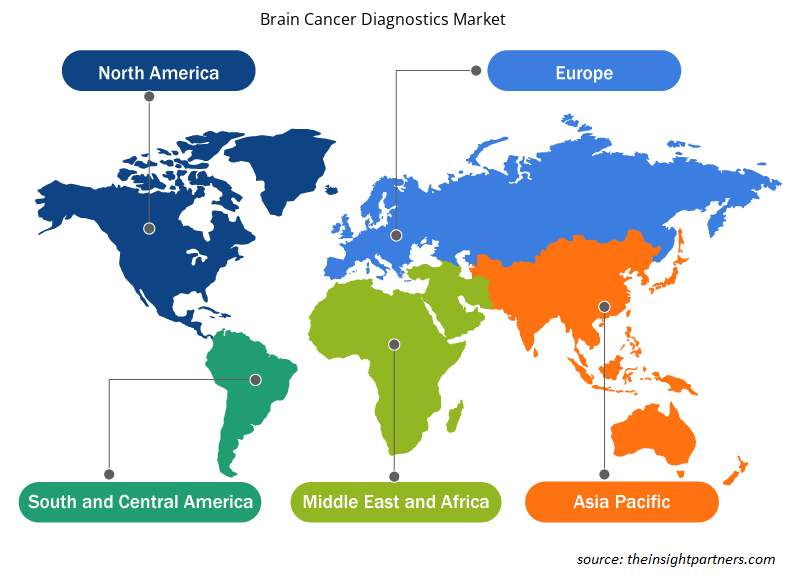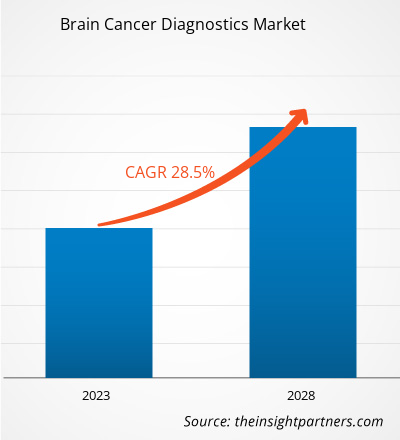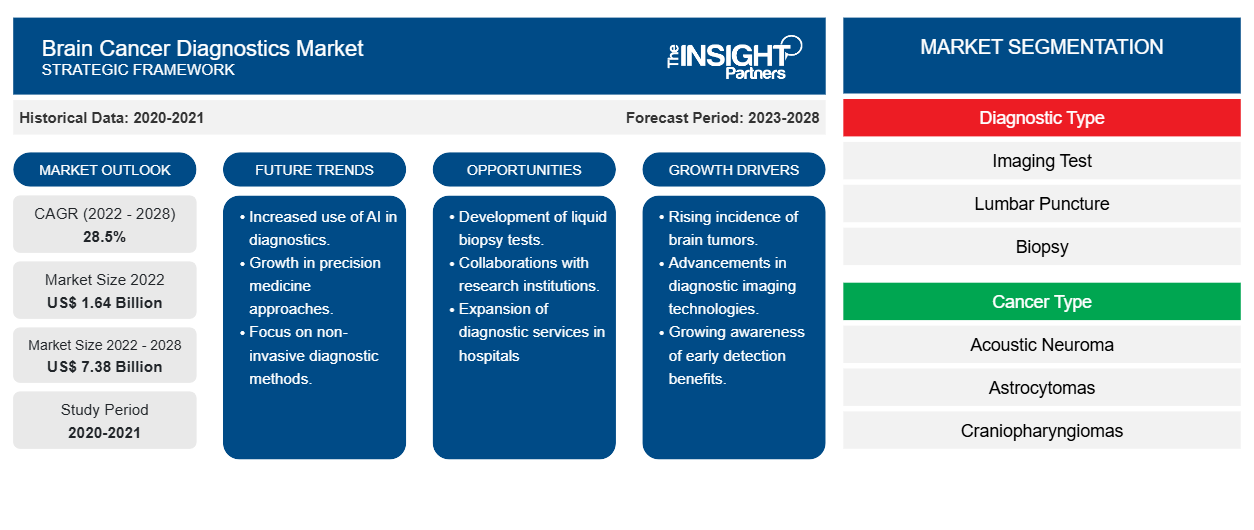Der Markt für Hirntumordiagnostik soll von 1.639,10 Millionen US-Dollar im Jahr 2022 auf 7.378,57 Millionen US-Dollar im Jahr 2028 anwachsen; von 2022 bis 2028 wird mit einer durchschnittlichen jährlichen Wachstumsrate von 28,5 % gerechnet.
Hirntumore entstehen durch extrazelluläres Wachstum der Zellen im Gehirn, das Tumore verursacht. Der Tumor umfasst primäre und sekundäre Hirntumore. Primäre Hirntumore bilden sich im Gehirn und breiten sich nicht auf andere Körperteile aus, während sekundäre Tumore, auch als Metastasen bekannt, Krebsarten sind, die in einem anderen Teil des Körpers beginnen. Hirntumore werden in 40 Haupttypen eingeteilt, die wiederum in zwei Hauptgruppen unterteilt werden: gutartig, d. h. langsam wachsend und haben eine geringere Ausbreitungswahrscheinlichkeit, und bösartig, d. h. krebsartig und mit höherer Ausbreitungswahrscheinlichkeit.
Der Markt für Hirntumordiagnostik ist segmentiert nach Diagnosetyp, Krebsart, Endnutzer, Tumorgröße und Geografie. Der Markt ist geografisch grob segmentiert in Nordamerika, Europa, Asien-Pazifik, den Nahen Osten und Afrika sowie Süd- und Mittelamerika. Der Bericht bietet detaillierte Einblicke in den Markt und betont Parameter wie Markttrends, technologische Fortschritte und Marktdynamik sowie eine Analyse der Wettbewerbslandschaft führender Marktteilnehmer.
Passen Sie diesen Bericht Ihren Anforderungen an
Sie erhalten kostenlos individuelle Anpassungen an jedem Bericht, einschließlich Teilen dieses Berichts oder einer Analyse auf Länderebene, eines Excel-Datenpakets sowie tolle Angebote und Rabatte für Start-ups und Universitäten.
-
Holen Sie sich die wichtigsten Markttrends aus diesem Bericht.Dieses KOSTENLOSE Beispiel umfasst eine Datenanalyse von Markttrends bis hin zu Schätzungen und Prognosen.
Markteinblicke
Steigende Fälle von Hirntumoren tragen erheblich zum Marktwachstum bei
Nach Angaben der American Society of Clinical Oncology (ASCO) wurden im Jahr 2021 in den USA bei rund 24.530 Erwachsenen (13.840 Männer und 10.690 Frauen) primäre Krebstumoren des Gehirns und des Rückenmarks diagnostiziert. Die Wahrscheinlichkeit, im Laufe eines Lebens an dieser Tumorform zu erkranken, liegt bei weniger als 1 %. Die meisten primären malignen Erkrankungen des zentralen Nervensystems (ZNS) sind Hirntumore, die 85 bis 90 % aller Fälle ausmachen. Hirntumore können tödlich sein, die Lebensqualität stark beeinträchtigen und letztlich das Leben eines Patienten und seiner Familie verändern.
Ebenso schätzte Cancer Research UK, dass in Großbritannien jedes Jahr etwa 12.288 neue Fälle von Hirntumoren, anderen Tumoren des zentralen Nervensystems und intrakraniellen Tumoren diagnostiziert werden, was etwa 34 Fällen pro Tag entspricht (2016–2018). Hirntumoren, andere Tumoren des zentralen Nervensystems und intrakranielle Tumoren sind die neunthäufigsten bösartigen Erkrankungen in Großbritannien und machen 3 % aller neuen Krebsfälle aus (2016–2018). Außerdem ist es die siebthäufigste Krebsart bei Frauen in Großbritannien, mit etwa 6.400 Neuerkrankungen in den Jahren 2016–2018. Ebenso sind bei Männern Hirntumoren, andere Tumoren des zentralen Nervensystems und intrakranielle Tumoren die elfthäufigste Krebsart, mit etwa 5.800 Neuerkrankungen in Großbritannien in den Jahren 2016–2018. Die Inzidenzraten für Hirntumore sind in Großbritannien bei Menschen im Alter von 85 bis 89 Jahren (2016–2018) am höchsten.
Laut der American Association of Neurological Surgeons ist das Glioblastom mit 47,7 % aller Fälle der häufigste bösartige Hirn- und andere ZNS-Tumor; die Inzidenz des Glioblastoms beträgt 3,21 pro 100.000 Menschen. Laut Cancer Australia wurden im Jahr 2020 in Australien rund 1.879 neue Fälle von Hirnkrebs diagnostiziert.
Eine frühe Tumorerkennung bietet oft mehr Behandlungsmöglichkeiten. Moderne Bildgebungstechnologie kann die Lage von Hirntumoren genau bestimmen. Intraoperative MRT kann auch bei der Gewebebiopsie und Tumorresektion während der Operation hilfreich sein. Die Magnetresonanzspektroskopie (MRS) wird zur Untersuchung der chemischen Eigenschaften von Tumoren eingesetzt. Daher ist die weltweit zunehmende Prävalenz von Hirntumoren ein dringender Bedarf an Diagnoseinstrumenten für Hirntumoren.
Diagnosetypbasierte Erkenntnisse
Basierend auf dem Diagnosetyp ist der Markt für Hirnkrebsdiagnostik in Bildgebungstests, Lumbalpunktion, Biopsie, molekulare Tests, Plattform und Dienste, zerebrales Arteriogramm, neurologische und Hörtests/neurokognitive Untersuchungen, Elektroenzephalographie (EEG) und andere unterteilt. Darüber hinaus ist das Segment Bildgebungstests in MRT, CT-Scan, PET und andere unterteilt. Ebenso ist das Segment Plattform und Dienste in Probenträger, Autosampler-Einheit, Lösungen und Plattform sowie Dienste unterteilt. Im Jahr 2022 wird das Segment Bildgebungstests wahrscheinlich den größten Marktanteil ausmachen. Es wird jedoch erwartet, dass das Segment Plattform und Dienste im Prognosezeitraum von 2022 bis 2028 die höchste durchschnittliche jährliche Wachstumsrate auf dem Markt für Hirnkrebsdiagnostik verzeichnen wird.
Erkenntnisse basierend auf Krebsarten
Der globale Markt für Hirntumordiagnostik ist nach Krebsart segmentiert in Akustikusneurinom, Astrozytome, Kraniopharyngeome, Ganglioneurome, Glioblastoma multiforme, Meningiome, Ependymome, Oligodendrogliom, niedriggradige Tumore und andere Hirntumorarten. Im Jahr 2022 dürfte das Segment Glioblastoma multiforme den größten Marktanteil halten. Darüber hinaus wird erwartet, dass die Nachfrage in diesem Segment von 2022 bis 2028 aufgrund der weltweit steigenden Inzidenz von Glioblastoma multiforme mit der höchsten CAGR wachsen wird.
Erkenntnisse auf Basis der Tumorgröße
Der globale Markt für Hirntumordiagnostik ist basierend auf der Tumorgröße in 0,2 cm3 bis 100 cm3, 101 cm3 bis 200 cm3 und über 200 cm3 segmentiert. Im Jahr 2022 dürfte das Segment 0,2 cm3 bis 100 cm3 den größten Marktanteil halten. Darüber hinaus wird erwartet, dass das Segment 0,2 cm3 bis 100 cm3 von 2022 bis 2028 aufgrund der zunehmenden Erkennung und Diagnose verschiedener Erkrankungen weltweit das schnellste Nachfragewachstum verzeichnen wird.CAGR from 2022 to 2028, owing to the rise in the detection and diagnosis of various medical conditions globally.
Endbenutzerbasierte Erkenntnisse
Basierend auf dem Endverbraucher ist der Markt für Hirntumordiagnostik in Krankenhäuser, Fachkliniken, ambulante chirurgische Zentren, Diagnosezentren und Forschungsinstitute und andere unterteilt. Im Jahr 2022 wird das Krankenhaussegment voraussichtlich den größten Marktanteil halten. Darüber hinaus wird erwartet, dass das Segment der Fachkliniken von 2022 bis 2028 mit einer durchschnittlichen jährlichen Wachstumsrate von 29,4 % das schnellste Nachfragewachstum verzeichnen wird, was auf die Einführung fortschrittlicher Technologien zur Hirntumordiagnostik durch Krankenhäuser weltweit zurückzuführen ist.CAGR of 29.4% from 2022 to 2028, owing to the adoption of advanced technologies for brain cancer diagnosis by hospitals globally.
Produkteinführungen, Fusionen und Übernahmen sind bei den Akteuren auf dem globalen Markt für Hirntumordiagnostik weit verbreitete Strategien. Nachfolgend sind einige der jüngsten wichtigen Marktentwicklungen aufgeführt:
Im September 2021 gaben BioReference Laboratories, Inc., ein Unternehmen von OPKO Health, zusammen mit seiner auf Onkologie spezialisierten Abteilung GenPath die Einführung von OnkoSight AdvancedTM bekannt, einem Sequenzierungstest der nächsten Generation (NGS), der ein revolutionäres Mutationsprofiling von Desoxyribonukleinsäure (DNA) in Tumorproben ermöglicht.BioReference Laboratories, Inc., an OPKO Health company, along with its specialty oncology division, GenPath, announced the launch of OnkoSight AdvancedTM, a next-generation sequencing (NGS) assay that enables revolutionary deoxyribonucleic acid (DNA) mutational profiling of tumor samples.
Geographiebasierte Erkenntnisse
Der globale Markt für Hirntumordiagnostik ist geografisch grob in Nordamerika (USA, Kanada und Mexiko), Europa (Frankreich, Deutschland, Großbritannien, Spanien, Italien und das übrige Europa), den asiatisch-pazifischen Raum (China, Indien, Japan, Australien, Südkorea und den Rest des asiatisch-pazifischen Raums), den Nahen Osten und Afrika (Saudi-Arabien, die Vereinigten Arabischen Emirate, Südafrika und den Rest des Nahen Ostens) sowie Süd- und Mittelamerika (Brasilien, Argentinien und den Rest Süd- und Mittelamerikas) unterteilt.
Regionale Einblicke in den Markt für Hirntumordiagnostik
Die regionalen Trends und Faktoren, die den Markt für Hirntumordiagnostik im Prognosezeitraum beeinflussen, wurden von den Analysten von Insight Partners ausführlich erläutert. In diesem Abschnitt werden auch die Marktsegmente und die Geografie der Hirntumordiagnostik in Nordamerika, Europa, im asiatisch-pazifischen Raum, im Nahen Osten und Afrika sowie in Süd- und Mittelamerika erörtert.

- Erhalten Sie regionale Daten zum Markt für Hirntumordiagnostik
Umfang des Marktberichts zur Hirntumordiagnostik
| Berichtsattribut | Details |
|---|---|
| Marktgröße im Jahr 2022 | 1,64 Milliarden US-Dollar |
| Marktgröße bis 2028 | 7,38 Milliarden US-Dollar |
| Globale CAGR (2022 - 2028) | 28,5 % |
| Historische Daten | 2020-2021 |
| Prognosezeitraum | 2023–2028 |
| Abgedeckte Segmente |
Nach Diagnosetyp
|
| Abgedeckte Regionen und Länder |
Nordamerika
|
| Marktführer und wichtige Unternehmensprofile |
|
Marktteilnehmerdichte: Der Einfluss auf die Geschäftsdynamik
Der Markt für Hirntumordiagnostik wächst rasant, angetrieben von der steigenden Nachfrage der Endnutzer aufgrund von Faktoren wie sich entwickelnden Verbraucherpräferenzen, technologischen Fortschritten und einem größeren Bewusstsein für die Vorteile des Produkts. Mit steigender Nachfrage erweitern Unternehmen ihr Angebot, entwickeln Innovationen, um die Bedürfnisse der Verbraucher zu erfüllen, und nutzen neue Trends, was das Marktwachstum weiter ankurbelt.
Die Marktteilnehmerdichte bezieht sich auf die Verteilung der Firmen oder Unternehmen, die in einem bestimmten Markt oder einer bestimmten Branche tätig sind. Sie gibt an, wie viele Wettbewerber (Marktteilnehmer) in einem bestimmten Marktraum im Verhältnis zu seiner Größe oder seinem gesamten Marktwert präsent sind.
Die wichtigsten auf dem Markt für Hirntumordiagnostik tätigen Unternehmen sind:
- THERMO FISHER SCIENTIFIC INC
- Siemens Healthineers AG
- GE-Gesundheitswesen
- MDxGesundheit
- NantOmics
Haftungsausschluss : Die oben aufgeführten Unternehmen sind nicht in einer bestimmten Reihenfolge aufgeführt.

- Überblick über die wichtigsten Akteure auf dem Markt für Hirntumordiagnostik
Unternehmensbasierte Einblicke
THERMO FISHER SCIENTIFIC INC; Siemens Healthineers AG; GE Healthcare; MDxHealth; NantOmics; Biocept, Inc.; Koninklijke Philips NV; Canon Medical Systems; Hitachi, Ltd.; Neusoft Medical Systems; KITZ HEIDELBERG; GENPATH; NVIDIA CORPORATION; ONCORA MEDICAL; BIOMIND; SOPHIA AND ONCODNA; Clinspec Diagnostics; Raindance Technologies, Inc; ROCHE DIAGNOSTICS; und Illumina, Inc gehören zu den führenden Unternehmen auf dem Markt für Hirnkrebsdiagnostik.
- Historische Analyse (2 Jahre), Basisjahr, Prognose (7 Jahre) mit CAGR
- PEST- und SWOT-Analyse
- Marktgröße Wert/Volumen – Global, Regional, Land
- Branchen- und Wettbewerbslandschaft
- Excel-Datensatz
Aktuelle Berichte
Verwandte Berichte
Erfahrungsberichte
Grund zum Kauf
- Fundierte Entscheidungsfindung
- Marktdynamik verstehen
- Wettbewerbsanalyse
- Kundeneinblicke
- Marktprognosen
- Risikominimierung
- Strategische Planung
- Investitionsbegründung
- Identifizierung neuer Märkte
- Verbesserung von Marketingstrategien
- Steigerung der Betriebseffizienz
- Anpassung an regulatorische Trends























 Kostenlose Probe anfordern für - Markt für Hirntumordiagnostik
Kostenlose Probe anfordern für - Markt für Hirntumordiagnostik